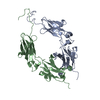+Search query
-Structure paper
| Title | C2 domain orientation of human immunoglobulin G in solution: Structural comparison of glycosylated and aglycosylated Fc regions using small-angle X-ray scattering. |
|---|---|
| Journal, issue, pages | MAbs, Vol. 11, Issue 3, Page 453-462, Year 2019 |
| Publish date | Dec 12, 2018 |
 Authors Authors | Seiki Yageta / Hiroshi Imamura / Risa Shibuya / Shinya Honda /  |
| PubMed Abstract | The N-linked glycan in immunoglobulin G is critical for the stability and function of the crystallizable fragment (Fc) region. Alteration of these protein properties upon the removal of the N-linked ...The N-linked glycan in immunoglobulin G is critical for the stability and function of the crystallizable fragment (Fc) region. Alteration of these protein properties upon the removal of the N-linked glycan has often been explained by the alteration of the C2 domain orientation in the Fc region. To confirm this hypothesis, we examined the small-angle X-ray scattering (SAXS) profile of the glycosylated Fc region (gFc) and aglycosylated Fc region (aFc) in solution. Conformational characteristics of the C2 domain orientation were validated by comparison with SAXS profiles theoretically calculated from multiple crystal structures of the Fc region with different C2 domain orientations. The reduced chi-square values from the fitting analyses of gFc and aFc associated with the degree of openness or closure of each crystal structure, as determined from the first principal component that partially governed the variation of the C2 domain orientation extracted by a singular value decomposition analysis. For both gFc and aFc, the best-fitted SAXS profiles corresponded to ones calculated based on the crystal structure of gFc that formed a "semi-closed" C2 domain orientation. Collectively, the data indicated that the removal of the N-linked glycan only negligibly affected the C2 domain orientation in solution. These findings will guide the development of methodology for the production of highly refined functional Fc variants. |
 External links External links |  MAbs / MAbs /  PubMed:30513259 / PubMed:30513259 /  PubMed Central PubMed Central |
| Methods | SAS (X-ray synchrotron) |
| Structure data |  SASDDG2:  SASDDH2: |
| Source |
|
 Movie
Movie Controller
Controller Structure viewers
Structure viewers About Yorodumi Papers
About Yorodumi Papers



 Homo sapiens (human)
Homo sapiens (human)